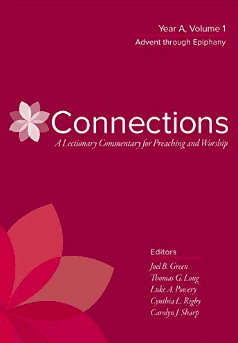 Everyone preaching the lectionary needs the wonderful series of books called Connections.
Everyone preaching the lectionary needs the wonderful series of books called Connections.
Big news: two volume at once. Here is a series of commentaries and reflections from Advent through Pentecost.
Now a suggestion: some of you preachers/pastors could give lectionary preaching a try, and there’s no better source than Connections for such a beginning. The lectionary has four texts for each week: Old Testament lesson, Psalm, a New Testament (often epistle), and the Gospel reading. This series has a commentary of exposition for each of these “lections.” Each lection has a commentary that connects the reading with the Bible and then a commentary that connects the reading to the world.
Buy one volume each season in the church calendar and in three years you will have a complete commentary on the whole lectionary. You will also have a multitude of suggestions on how to connect the texts to our world.
The editors — JB Green, Thomas Long, Luke Powery, Cynthia Rigby, Carolyn Sharp — have selected biblical scholars (yes, I was honored to participate in this series) and preachers and I have found every one of the commentaries/connections I have read to be very suggestive. The focus is the Bible, shaped by lectionary, aimed at the preacher.
The two newest volumes in this series:
The genius of these volumes is that “connections” are two-fold: two commentaries from two different connections made — on each reading in the lectionary for that day.
A pair of complementary commentaries on each of the Old Testament, Epistle, and Gospel readings. Both commentaries will exegete the lection by identifying distinct, yet related, sets of connections with the text. Commentary 1: Connecting the Reading with Scripture will explore the biblical connections of the reading by attending to whatever range of issues (e.g., textual, theological, historical, pastoral, ethical, homiletical) emerge as the passage is interpreted in the context of the biblical witness as a whole.
Commentary 2: Connecting the Reading with the World will examine connections with the world of the hearer by attending to the range of issues (e.g., political, economic, geographical, social, ecclesial, cultural) that emerge as the passage is
interpreted in the context of the world of the Bible and our world today. It’s important to note that, while these commentaries will be written separately, they share a common purpose: to connect the world of Scripture to the life and experience of the children of God. We envision a natural and organic relationship between the two. While exploring the different connections between the reading and the larger biblical witness, Commentary 1 will always be thinking forward to the conversation with the contemporary world. Likewise, Commentary 2 will always look for ways the
contemporary connections of the particular reading are related to the Scriptures more broadly.











